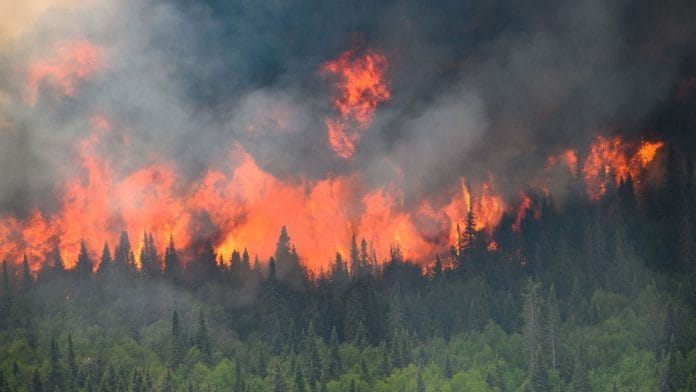Bengaluru: The record-breaking wildfires that engulfed Canada for nearly a year last year, released in a mere few months—between May and September—carbon emissions greater than the annual fossil fuel emissions of large industrialised nations, except India, China and the US.
Burning through 15 million hectares of forest cover, the wildfires destroyed a forested area more than seven times the annual average area engulfed by such fires in the past 44 years.
The forest fires occurred from March to November, and resulted in over 2,30,000 people being evacuated.
The study, led by Brendan Byrne of NASA’s Jet Propulsion Laboratory (JPL), was published last week in the journal Nature.
JPL scientists used observational data obtained from a European Space Agency (ESA) satellite to quantify carbon emissions from these megafires.
The data indicated that the total emissions of this time period was 647 TgC (teragrams of carbon), or about 640 million metric tonnes of carbon. One teragram is equal to 10^12 grams, and one metric tonne is equal to one million grams (10^6 grams).
The hot and dry weather in Canada aggravated the rapid spread and persistent burning of the wildfires. Data indicated that last year was Canada’s warmest and driest year since at least 1980.
The authors of the paper highlighted that while temperatures in Canada last year were extreme, they are expected to become the norm in 25 years, exacerbating already deadly fire disasters.
How JPL scientists calculated carbon emissions
Carbon emissions due to forest fires can be tracked from space with the help of satellites observing the Earth in different wavelengths. These measurements enable fairly accurate calculations of emissions of specific gases such as carbon dioxide, carbon monoxide, and methane, among others.
The authors also incorporated technical modifications in their analyses which enabled them to calculate data from both flaming fires as well as smouldering combustion (flameless process that converts organic material into carbon dioxide, heat and water).
Incidentally, the NASA scientists worked on data from the ESA’s TROPOspheric Monitoring Instrument (TROPOMI), a payload onboard the Sentinel-5P satellite which measures solar radiation reflected by and radiated from the Earth.
Canada’s forested areas were warmer than average last year
The satellite data showed that the five-month emissions (647 TgC) were four times higher than Canada’s annual fossil fuel emissions, and close to India’s annual emissions (740 TgC).
The climate data also revealed similar extremes. From May to September last year, 100 percent of forested areas in Canada were warmer than average, and over 85 percent had below average rain.
In the paper, the authors discussed the implications of such fires, as well as the role of Canadian fire management authorities and their strategies in dealing with them effectively.
The authors also added that the temperature extremes of 2023 will be considered ‘normal’ by 2050, and this is likely to increase fire activity. This, in turn, will affect emission limits set by climate targets.
“Understanding how fire regimes will change with climate change is thus of high importance, for future decision criteria and costing,” the authors wrote in the paper.
What causes forest fires
Many boreal forest systems (Earth’s northernmost forests) around the world have a seasonal or annual fire season, where old growth is burned away naturally, allowing new plants to grow.
The naturally occurring process, sometimes even aided historically by native cultures, is required for cyclical plant growth, with the fire helping burst open hardy seeds that can otherwise survive in harsh and adverse conditions.
With global temperatures increasing rapidly every year, regions of regular wildfire are witnessing consistent anomalies on the extreme end, as the air becomes warmer and drier.
These periodically cycling forests constitute huge portions of forested areas, one of the biggest carbon sinks on the planet. In Canada, forests cover an area of over 360 million hectares, making up 8.5 percent of the global forested area.
(Edited by Radifah Kabir)
Also read: Mars may have oceans’ worth of water underground, but this doesn’t mean it’s ready to be colonised






